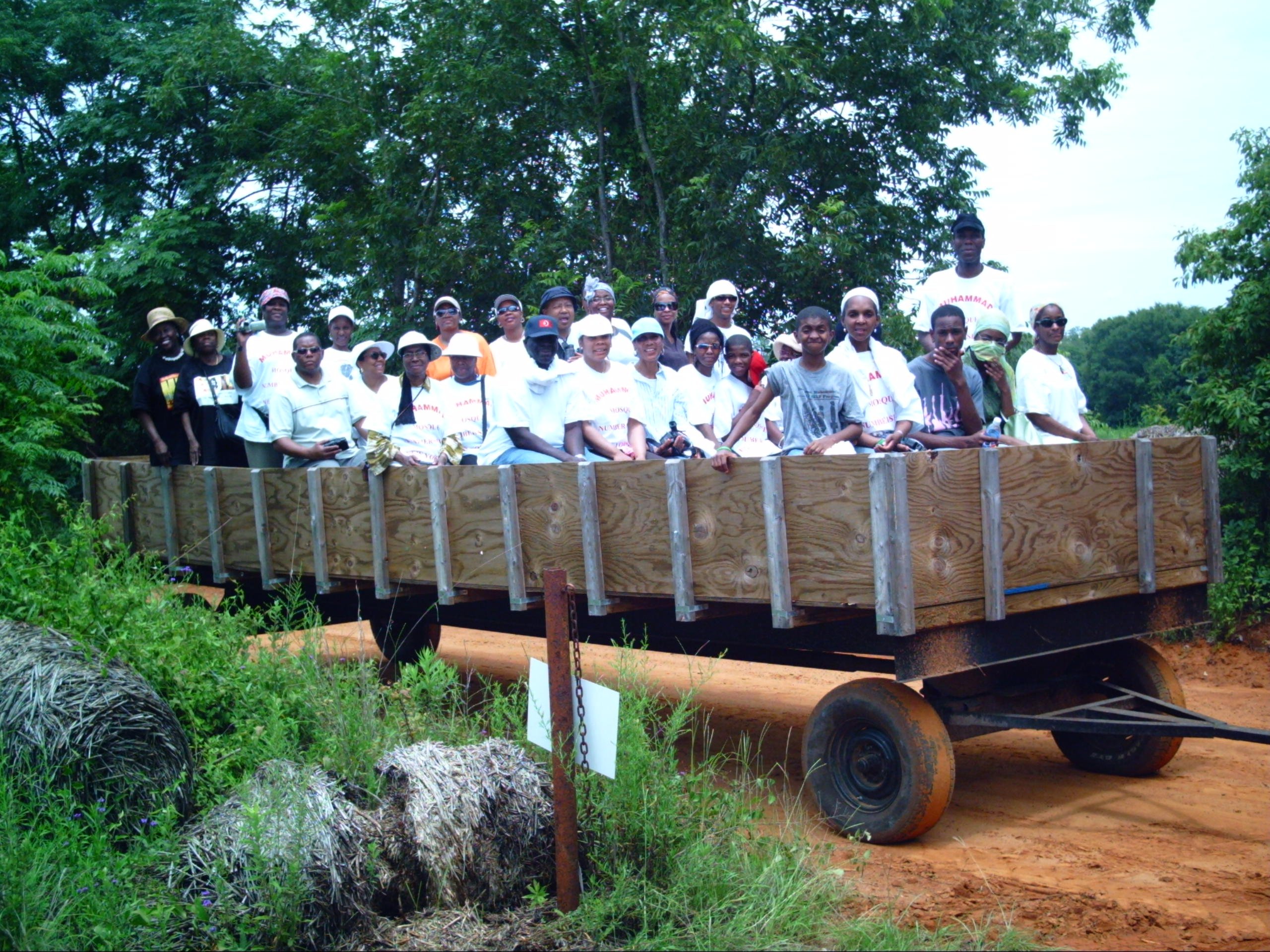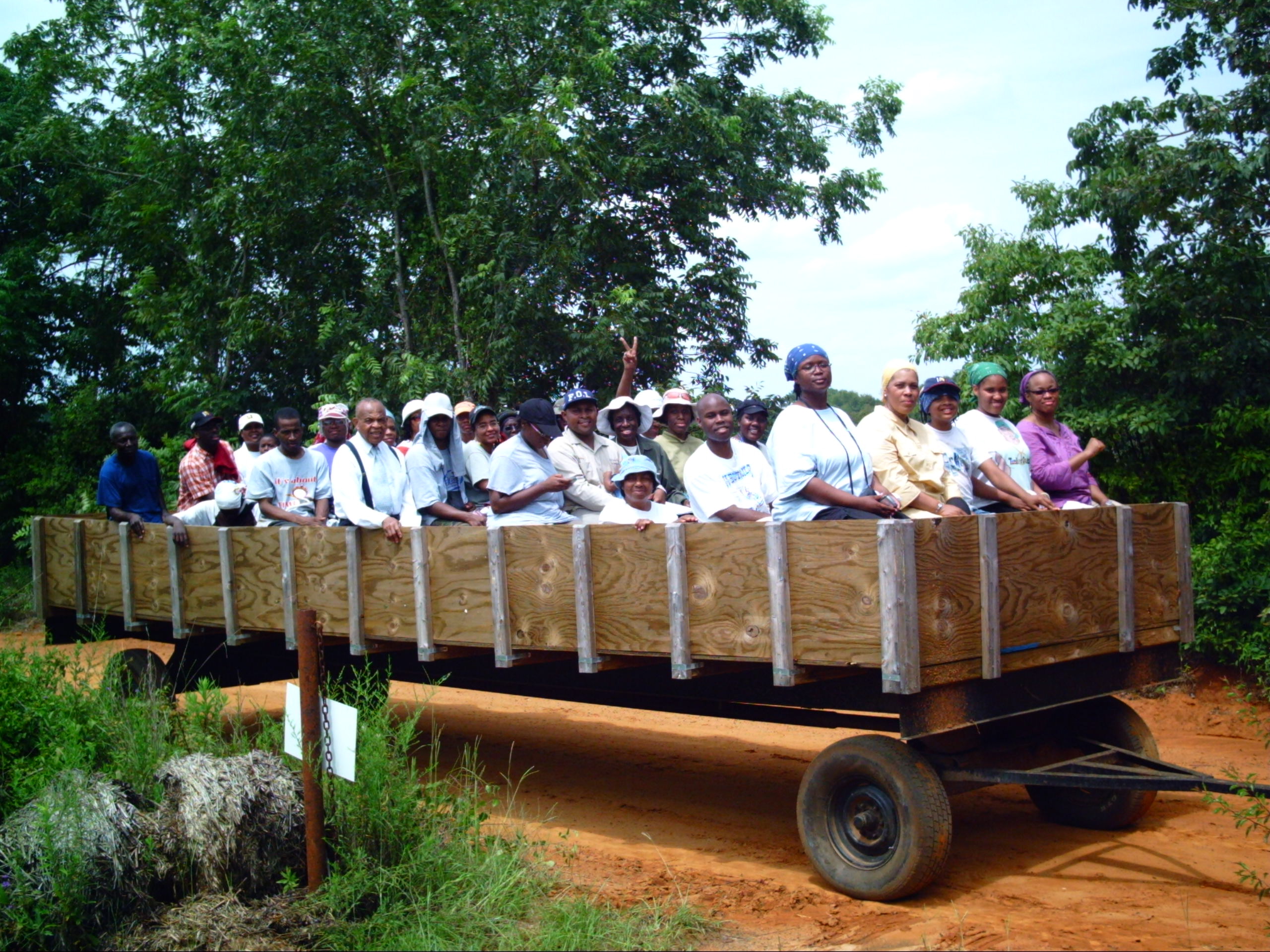Volume 10, Number
8
July 15, 2007
The Farmer
———————————————————————-
Founder’s Day at Muhammad Farms
by Dr. Ridgely Abdul Mu’min Muhammad
Over 200 guests visited Muhammad Farms on Saturday, July 7th to help us celebrate the
77th anniversary of Master Fard Muhammad making Himself and His Mission known on July 4,
1930 in Detroit, Mich. The activities really started on Friday evening with a fish fry at the
Ministry of Agriculture House in Bronwood, Ga. which served as a networking experience from
Believers from across the country. The highlight of the dinner was that good old fish sandwich that
the Nation of Islam is known for. The fish was dipped, of course, in a batter consisting of Muhammad
Farms Whole Wheat Flour recently milled from 40 acres of wheat harvested in June of this year.
On Saturday our goal was to give our 200 visitors a taste of farming and rural life as compared
to the cities where they came from. We had buses to come form Newark, N.J., New York City and
Atlanta. Cars and vans came from as far away as Minnesota, Arkansas, Washington, DC and Texas. In
the morning we divided the visitors up into five different work groups. One group picked and washed
squash. Another group picked watermelons that were loaded out of the field by another group. A group
picked sweet corn, while a separate group processed the corn by cutting off the tips. We have to cut
the tips out of our corn because we do not use any chemicals to kill the corn ear worm that usually
eats a few kernels of the corn at the very tip. We pointed out to them that when we grow sweet corn
without pesticides, we can not turn around and sell this corn to the open market, because they
demand that we use chemicals to kill all corn ear worms that might eat a little bit of the corn at
its tip.
One of participants in the corn harvest Sister Khashimah Muhammad of Little Rock, AR stated,
“Its one thing to hear about ‘our farm’ half way across the country, but to go and see the
fields of corn, wheat, watermelons, eggplant and other vegetables and see some of the work involved
in maintaining it was an inspiring and awesome experience. The cutting and the bagging of the corn
that I helped to do was only a small taste of the daily work that goes on at Muhammad Farms.”
After fighting the gnats, mosquitoes and heat our visitors cut into some freshly picked
watermelons as they waited on their “hay ride” tour of Muhammad Farms. The hay ride wagon
was loaned to us by a long time friend and supporter of the Nation from Leesburg, Ga, Reverend
Roosevelt Carter. Even with our 40 passenger wagon, it took us 5 trips to give everyone the tour of
our and your 1600 acre farm. The visitors saw fields of squash, navy beans, peanuts, watermelons,
sweet corn, field corn, soybeans, eggplants and cantaloupes. Since the Honorable Elijah Muhammad’s
book called “How to Eat to Live” taught us not to eat peanuts and soybeans, some of our
visitors wanted us to explain why we grew them.
There are both agronomic and economic reasons for us in Southwest Georgia to grow peanuts and
soybeans especially since we do not want to use artificial fertilizers and herbicides. The economic
reason for growing peanuts and soybeans is that there is a local infrastructure set up to pick,
purchase and transport these commodities. With the donations from the Three Year Economic Savings
Program we purchased a used grain combine and peanut picker. These machines enable us to harvest as
much as 20 to 40 acres per day of navy bean, soybeans, wheat, field corn and peanuts. On the other
hand in a two hour period it took 20 people to pick 2 acres of sweet corn. If I paid these visitors
$7 per hour, the cost would be $140 per acre. On the other hand the estimated cost of running a
grain combine to pick field corn or wheat is $30 per acre and a lot less headaches. Therefore we can
pick 200 acres of field corn or peanuts in 10 days using only one tractor driver. Whereas, if we
were to use 20 hand pickers in an 8 hour day, it would take us 200/8 or 25 days under perfect
weather conditions.
After we pick the field corn, peanuts and soybeans, we can put them on trailers and drive 8 miles
where we can sell them, get paid that day, and be back at the farm within and hour. On the other
hand if we grew 200 acres of sweet corn, I would have to drive all over the country to get them sold
and have to worry about refrigeration on top of that because there is no local market for that much
chemical free sweet corn.
George Washington Carver saved the agriculture of the South by introducing the peanut to replace
the nutrients taken from the soil by cotton and corn. Peanuts, soybeans and navy beans put nitrogen
back into the soil that is available for the next crop planted in rotation behind the peanuts. In
addition, since peanuts are a root crop, their very growth and harvesting help to break up the hard
red clay at Muhammad Farms, conditioning the soil for the next crop to be grown. In addition,
peanuts spread out and choke the weeds reducing the weed population in a field where you can then
grow another crop and not have to spray chemical herbicides to protect your crop.
The tour was followed up with fun and games for the children at the Ministry of Agriculture House
along with a dinner prepared by Sister Anne from produce from Muhammad Farms including eggplants,
squash and sweet corn capped off by a slice of Muhammad Farms watermelon. Sis. Constance Muhammad
commented, “I am especially appreciative that our children were allowed to participate with us
in going out into the field and assisting with our gathering efforts. It was the highlight of their
day! The food was wonderful as always and the lecture was thought provoking.”
After dinner, as advertised, we gave a PowerPoint presentation on the significance of July 4,
1930 and why Master Farm Muhammad may have chosen this date for the announcement of Himself and His
Mission. The presentation is called “Two in the Womb” and is dedicated to show why July 4,
1930 was so significant from an astronomical point of view and why Master Fard Muhammad may have
chosen this date to make Himself and His Mission known. The lecture turned into a mini-course on the
fallacies of western economic theory and introduced a new paradigm based on the Messenger’s
Economic Blueprint.
On Sunday we took our annual “Footsteps of the Messenger Tour” through Cordele, Macon,
DeepStep, and Sandersville, Ga. After the tour Sister Khashimah Muhammad stated, “I really
appreciated and enjoyed the tour of the Honorable Elijah Muhammad footsteps. Being in some of the
same places, hearing some of the stories of his life and just seeing the environment that helped to
shape one of the greatest men in our history, meant a lot to me. The entire weekend was a learning
experience. My family and I are in our second year having a garden, and seeing the daily attention
it needs and the experience at Muhammad Farms lets me know that we all must be involved in the
agricultural ministry in some way to reach and feed all of our people.”

Mosque #7, New York City visitors on Farm Tour

Visitors from Minnesota, Louisiana, Mississippi, North Carolina, and Arkansas

when are gonna do the weekly report again everything you have on here is kinda old